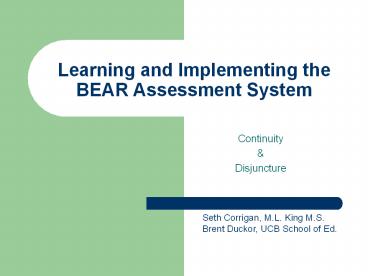Learning and Implementing the BEAR Assessment System - PowerPoint PPT Presentation
1 / 13
Title:
Learning and Implementing the BEAR Assessment System
Description:
Seth Corrigan, M.L. King M.S. Brent Duckor, UCB School of Ed. The Work Circle ... Offers bridge between 'researchers' and 'practitioners' ... – PowerPoint PPT presentation
Number of Views:112
Avg rating:3.0/5.0
Title: Learning and Implementing the BEAR Assessment System
1
Learning and Implementing the BEAR Assessment
System
- Continuity
- Disjuncture
Seth Corrigan, M.L. King M.S. Brent Duckor, UCB
School of Ed.
2
The Work Circle
- Builds on and extends research for practice
tradition - Quality Circles and Japanese Lesson Study
- LETUS at Northwestern University
- Offers bridge between researchers and
practitioners - Faculty and graduate students from UCB-GSE
- Curriculum developers from LHS-FOSS
- National trial teachers-FOSS
- Content and technology experts in e.g. Physics
education - Focuses on knowledge of assessment and
products for use in national science curriculum
3
Acquired Knowledge Skills
- Progress Map Design
- Outcome Space Design
- Item Design
- Item Paneling
- Methods of Data Analysis
- Qualitative
- Quantitative
4
Changes in Beliefs
- Knowledge Gains
- The Systems View of Assessment!
- Building chains of inference from progress maps,
scoring guides and items - Role of validity evidence in evaluating
assessment tools - The idea of a measurement model to check
expectations
- Values shift
- Developmental perspective
- Levels of understanding in between expert and
novice - Dynamic assessment
- When and why students gain more of a concept over
time - Embedded assessment
- Curriculum overlaps with assessment
5
Ideal Impact on Assessment Practices for Teachers
Progress Map Curriculum
Items, Activities and Scoring Guides
Reflection Analysis
Teaching Assessment
Validity established at each stage
6
Progress Maps Ideal vs. Real
- Ideal
- Create progress maps and outcome spaces which are
distinct. - Make Inferences of student understanding using
responses, outcome space and progress maps. - Revise progress maps as part of assessment cycle.
- Establish both content validity and
statistical/technical validity of progress map.
- Real
- Create progress maps and outcome spaces which are
integrated. - Make inferences about student understanding using
only responses and outcome space. - Forego revision of progress maps.
- Establish only content validity of progress maps.
7
Outcome Space Ideal vs. Real
- Ideal
- Use outcome space to make inferences about
changes in student position of progress map. - Dynamic assessment
- Create one outcome space for each progress
variable. - Develop well ordered outcome spaces that describe
all possible responses and permit consistent
scoring.
- Real
- Use outcome space as description of student
understanding. - Static assessment
- Create several outcome spaces for each progress
variable. - Develop well ordered outcome spaces that describe
all possible responses and permit consistent
teacher AND student scoring.
8
Item Development Ideal vs. Real
- Real
- Assign primarily open ended items.
- Evaluate item function loosely through
qualitative review of student responses.
- Ideal
- Assign a range of item types to ensure
reliability and validity. - Evaluate item function quantitatively.
9
Communities beyond the Work Circle
10
Interacting with the CommunityGeneral Education
Teachers
- Going beyond rubrics
- Problematizing current assessment practices
- Investing more in assessment
11
Interacting with the CommunitySPED Teachers,
Administrators
- Communicating progress
- Diagnosing problems
- Setting goals
12
Interacting with the CommunityStudents
- Providing detailed Feedback
- Informing Decisions about Instruction
- Shaping Students Experience and Cognitive
Processing of Material
13
Summary Areas of Change

